Project1 Giving an oral report 导学案
示范【公开课教案】(Period 8 Project)
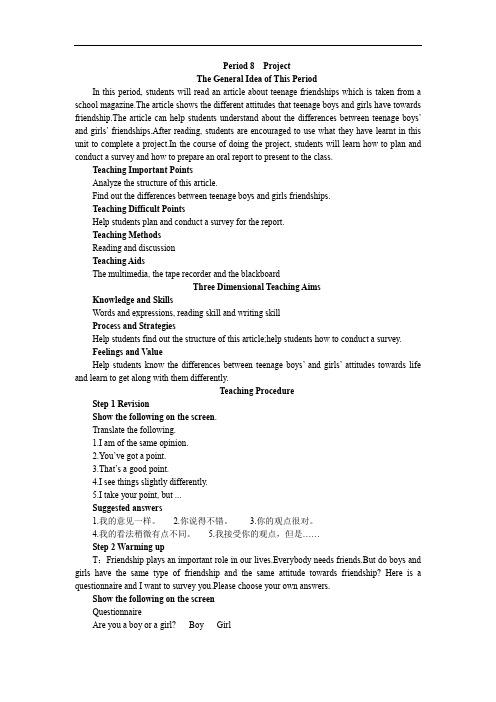
Period 8ProjectThe General Idea of This PeriodIn this period, students will read an article about teenage friendships which is taken from a school magazine.The article shows the different attitudes that teenage boys and girls have towards friendship.The article can help students understand about the differences between teenage boys’ and girls’ friendships.After reading, students are encouraged to use what they have learnt in this unit to complete a project.In the course of doing the project, students will learn how to plan and conduct a survey and how to prepare an oral report to present to the class.Teaching Important PointsAnalyze the structure of this article.Find out the differences between teenage boys and girls friendships.Teaching Difficult PointsHelp students plan and conduct a survey for the report.Teaching MethodsReading and discussionTeaching AidsThe multimedia, the tape recorder and the blackboardThree Dimensional Teaching AimsKnowledge and SkillsWords and expressions, reading skill and writing skillProcess and StrategiesHelp students find out the structure of this article;help students how to conduct a survey.Feelings and ValueHelp students know the differences between teenage boys’ and girls’ attitudes towards life and learn to get along with them differently.Teaching ProcedureStep 1 RevisionShow the following on the screen.Translate the following.1.I am of the same opinion.2.You’ve got a point.3.That’s a good point.4.I see things slightly differently.5.I take your point, but ...Suggested answers1.我的意见一样。
高二英语:M6U1Project知识点导学案
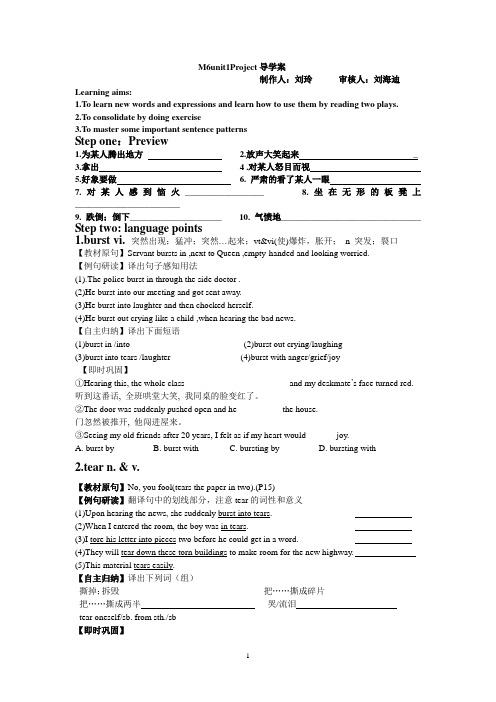
M6unit1Project导学案制作人:刘玲审核人:刘海迪Learning aims:1.To learn new words and expressions and learn how to use them by reading two plays.2.To consolidate by doing exercise3.To master some important sentence patternsStep one:Preview1.为某人腾出地方2.放声大笑起来_3.拿出 4 .对某人怒目而视5.好象要做6. 严肃的看了某人一眼7.对某人感到恼火__________________ 8.坐在无形的板凳上________________________9. 跌倒;倒下_____________________ 10. 气愤地________________________________ Step two: language points1.burst vi. 突然出现;猛冲;突然…起来;vt&vi(使)爆炸,胀开;n 突发;裂口【教材原句】Servant bursts in ,next to Queen ,empty-handed and looking worried.【例句研读】译出句子感知用法(1).The police burst in through the side doctor .(2)He burst into our meeting and got sent away.(3)He burst into laughter and then chocked herself.(4)He burst out crying like a child ,when hearing the bad news.【自主归纳】译出下面短语(1)burst in /into__________________________(2)burst out crying/laughing_________________ (3)burst into tears /laughter________________(4)burst with anger/grief/joy________________ 【即时巩固】①Hearing this, the whole class ________ ______ ________ and my deskmate’s face turned red. 听到这番话, 全班哄堂大笑, 我同桌的脸变红了。
M5U1ProjectGivinganoralreport

M5U1 Project Giving an oral reportStep1 Make a surveyTick the answer which most applies to you .1.How many best friends do you have?A. A lot B .A few C. None2.How often do you have a long conversation with your friends?A. Once a weekB. SeldomC. Never3.What topics do you mostly talk about with your friends ?A. Hobbies and interestsB.Families and friendsC. School and studyD.Emotions and feelingsE.Future planes and dreams4.Do you share your secrets with your best friends?A. AlwaysB. SometimesC. Never5.Do you think boys and girls have the same attitudes towards friendship?A. YesB.NoMake a report : What different attitudes do they have ?Step2 Teenager’s FriendshipFast reading: Structure of the articlePart1(Para )The boy’s puzzlement about the friendship between girls.Part2 (Para )in friendships between and .Part3(Para )Regardless of the differences, there areCareful Reading1) Para2-4 Difference2)Para5 SimilaratiesWhat are the similarities between boys’friendships and girls’friendships?Step3 What friendship means to mePart1 (para ) What’s the most important thing in life for the writer Part2(para ) What friendship means to the writerPart3 (para )What can always be rememberedStep4 Language pointsFind out the following useful expressions from P18-191.对待---有不同态度10意味着2.以----为基础11去观光3.对----谨慎12最终4.迫不及待做13依靠5.犹豫14复习6.忙于15幸亏7.毫不犹豫地回答这个问题16对----忠诚8.无论17对---做了一些残酷评论9.想象做--- 18向----道歉19总之20 回顾Important sentences1.They‘re still sitting on the sofa, continuing the same conversation... (V-ing 作伴随状语) 上句可转换为:They are still sitting on the sofa, and ________ the same conversation.翻译:老人在他的妻子的搀扶下走进了房间.The old man went into the room, ________(follow) by his wife1).They walked along the river, . (talk and laugh) .2)The professor stood there __________ by many students. (surround)3.)The professor went into the office, _______ by many students. (follow) 2.When asked, they usually hesitate before responding.上句可转换为:.When________ ,they usually hesitate before responding并列句,状语从句变成分词的条件:________翻译:老人在他的妻子的搀扶下走进了房间.1.当被警察询问时,他保持沉默.2.我不会原谅他的除非被告诉真相.3. A boy is likely to be cautions about sharing his feelings with his close friends.总结句式:句式转换:He is likely to tell us the truth.he will tell us the truth.翻译:他可能会赢得比赛。
oral_presentation
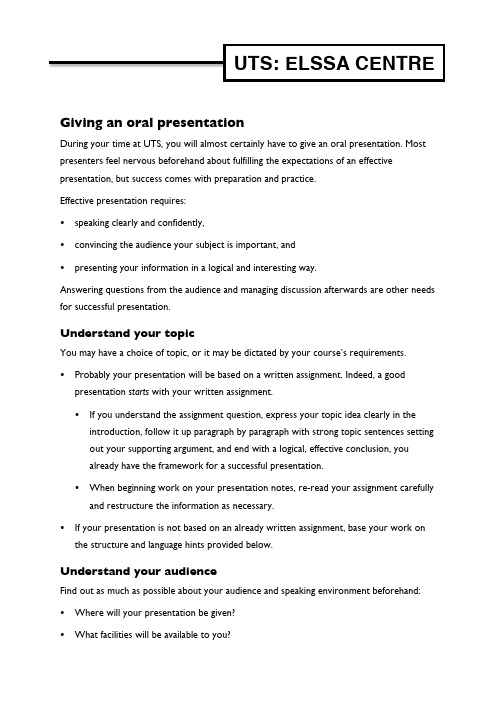
Giving an oral presentationDuring your time at UTS, you will almost certainly have to give an oral presentation. Most presenters feel nervous beforehand about fulfilling the expectations of an effective presentation, but success comes with preparation and practice.Effective presentation requires:• speaking clearly and confidently,• convincing the audience your subject is important, and• presenting your information in a logical and interesting way.Answering questions from the audience and managing discussion afterwards are other needs for successful presentation.Understand your topicYou may have a choice of topic, or it may be dictated by your course’s requirements. • Probably your presentation will be based on a written assignment. Indeed, a good presentation starts with your written assignment.• If you understand the assignment question, express your topic idea clearly in the introduction, follow it up paragraph by paragraph with strong topic sentences setting out your supporting argument, and end with a logical, effective conclusion, youalready have the framework for a successful presentation.• When beginning work on your presentation notes, re-read your assignment carefully and restructure the information as necessary.• If your presentation is not based on an already written assignment, base your work on the structure and language hints provided below.Understand your audienceFind out as much as possible about your audience and speaking environment beforehand: • Where will your presentation be given?• What facilities will be available to you?•Who is the audience? What is their background – general or specialist? Will they be familiar with your topic and understand specialist language? Or will they need to have matters expressed in relatively simple lay terms? Is there something they really need to know?Ensure your audience understands you1.You need to be sure about your presentation’s purpose. Are you presenting anargument to persuade, or an explanation that describes something?2.Concentrate on the essentials – your thesis, the support, what you have shown andyour concluding point, and exclude details that might detract from the strong thread of meaning.3.Carry the audience with you by using words that include them (you, we, us) and signalthe stages of your talk (first, second, third...).Organise your notes•Don’t read your presentation like a speech.•Have a paper with main headings and points, or use palm cards. Using notes will help you achieve a more natural style.Time yourself•Speaking too quickly means the audience may not understand you properly.•Speaking at a leisurely pace gives you time to pronounce words clearly and for the audience to take them in.•Estimate that you will speak at between 80 and 90 words a minute and tailor your notes accordingly.•Also, allocate the time appropriately between the introduction, body and conclusion of your talk, and allow time for the discussion phase.Practise wellPractise before a good friend (or even a mirror!), or with other presentation team members, and give one another constructive feedback about your body language, speaking style and timing.Don’t let nerves get to you•Having faith in the focus, message, argument of your presentation and the knowledge that you have done the best possible preparation are the best cures for nerves.•Take a deep breath, speak out and smile.•Remember, there may be someone at the back of the room who cannot hear well!•Conceal your nerves by always facing the audience, smiling at them, making eye contact around the room, and coming forward towards them instead of hiding behind thelectern.•If you are enthusiastic and properly prepared, your nerves will vanish by the time you have finished your introduction.Structuring your presentationAn oral presentation:•has an introduction, body and conclusion,•may include visual aids,•is usually followed by questions and discussions, and•may also have a handout for the audience to take away.Introduction•The introduction must totally orient the audience to your subject and purpose. To capture interest and set up rapport, it should tell the audience what to expect.•Be sure to carefully define the central point (or thesis) that is the basis of your talk and ensure that your supporting argument or information relates closely to it.•If you are not proceeding from an already written assignment, it might help to think of your introduction as funnel-shaped, with the content coming out of the funnel:INTRODUCTIONThe introduction should narrow down from a broad topic to the specifics of your talk.Zero into your thesisPreview the contentStaging the introductionFunctionExamples of signpost language Greet the audienceGood morning/afternoon distinguished guests/ladies and gentlemen/colleagues (whichever is appropriate) Express specialacknowledgements ifappropriateI’d like especially to welcome… I’d like to thank… Signal question/discussion opportunityThere will be time for questions and discussion at the end of my talk. If you have questions, please feel free to interrupt. Introduce your carefullydefined topicI’d like to talk to you about… Explain the topic area andpurpose This presentation will cover mainly… I am going to show that…I will argue that…Telecommunications in the Antarctic Weather, cost, manageability, performance That VoIP is best Explain how VoIP addresses all the issues Choosing a new telecommunication systemDispose of a distraction or side issue Before I start, let me clarify one point… My discussion will not cover…Briefly preview the organisation of the body of your talk The main points I will make are, first… second… and third…The subject can be examined under the following headings…We can divide this area into a number of fields. They are…Provide important history and/or definitions As background, it’s important to note that… By X I mean…Remind the audience of thetopic and give it statusSo we can see that (the topic) involves…BodyThe body of the presentation should meet the promises of purpose and information made in the introduction.Structure is crucial:•Whether you organise by chronology, priority, or theme, the body of your talk must proceed logically with the main points brought out one by one, with concise andrelevant supportive evidence, statistics or examples and verbal ‘signposting’ yourprogress through your argument or report.•You could present each important idea or point several times in different ways, becausea listening audience needs several opportunities to fully absorb meaning.•You need to state clearly the links between your ideas and always signal when the next point is coming. If you think something is particularly important, say so and why.If you don’t have a written assignment, it will help to think of your main points as paragraph topic sentences, each of which needs to be followed by supporting sentences and a conclusion.Staging the body of your talkFunction Examples of signpost languageBegin the body of the talk The first point I would like to address is… Let me first raise…Develop the first point For example…This is especially important because…Sum up the first point So, we can see that… Introduce the second point Secondly, I’d like to turn to…Develop the second point An important statistic in this area is… It means that…Sum up the second point It’s evident that…Bring in the final point Finally, we need to look at…Develop the final point This situation exists because… It’s worth noting that…Sum up the final point Thus, the result is…Emphasising a point I’d like to stress that… Let me repeat that…Introducing a contrasting idea By the way… Incidentally…Sum up the body of the talk and remind listeners of the topic To summarise…To review, we have found that… What I have been saying is that…Handing over to a co-presenterYour talk may be a group presentation with two or more speakers. You need to manage the handover gracefully, for example:I would like to conclude my discussion/report at this point and hand over to my partner/colleague XYZ who will examine/discuss/report the area/topic/perspective of…ConclusionSimilar to a written assignment, the conclusion again states your main points and what has been learned or shown but you also may raise implications inherent in the findings and offer creative recommendations.Staging the conclusionFunction Example of signpost languageSignal the end of your talk iscomingRemind the audience again ofthe topicIn conclusion, we have examined the question that…Remind the audience of yourargumentWe discussed…Remind the audience of yourfindingsThe evidence shows that…Alert the audience that youhave thought deeply about thetopicAn important implication is…Offer an innovative, provoking thought to take away I would like to offer recommendations to address this. Firstly… Secondly…Signal the end of your talk Thank you for your time and attention today.Signal the question/discussionsessionI’d now like to open the floor for questions and discussion.VisualsVisuals are an important part of a presentation. They can illustrate, clarify, and aid analysis of complex issues. Keep them simple. They should enhance, not muddle, your message. When you prepare a visual:•Limit the number of visuals. Too many means less impact on your audience.•Make only one key point per visual. Your listeners should be able to read and understand a visual in five seconds or less.•Make visuals large enough to be seen by everyone.•Use large type and simple lettering.•Do not use whole sentences. Write visuals like newspaper headings.•Use diagrams, graphs, pictures, maps and charts instead of words where possible and always explain them briefly in your talk.•Eliminate all unnecessary details.•Do not show a page full of numbers.•No more than three curves on a graph.•No more than three colours on a visual.Questions and discussionWhether questions and discussion are raised during your presentation or after it, you need to manage the audience strategically:•Ask the audience to keep their questions brief and confined to one or two points.•If you receive a question you are confident to answer, thank the questioner, repeat or summarise the question in case others have not heard it clearly, and respond briefly.•Do not simply ask for questions. Have a moderately contentious point lined up to start the discussion if no-one in the audience speaks up. It could relate to your main message, something stressed in your presentation, an implication or recommendation.Managing a discussionFunction Examples of discussion languageRaise a starting point An important perspective we should consider first is… What do people think about…?What if the result was…?Has it occurred to you that…?Give your opinion As far as I’m concerned…I would say that…It’s quite clear that…I think…Agree I take your point.I don’t think anyone would disagree with that. That is logical.I’d go along with you on that.Disagree I can’t say I share your view.I can’t see how that can be. But it could be argued that…Manage interruptions (you may also need to do this during your presentation) Thank you. I was just coming to that.I plan to deal with that later.Can we leave that until discussion time?Thank you, but some other points need to come first.Dealing with difficult questionsDon’t feel rattled by questions you can’t answer easily. Here are some suggestions for formulating replies.Function Examples of languageThank the questioner Thank you for the question.That’s a good question. Thank you for that.Ensure everyone has heardthe questionX has asked …Seek clarification from thequestionerCould you say a little more about that?Choose a strategy to give yourself time That’s something I’d like to give some thought to. I’d like to think about that.Seek information from the audience and promote discussion That’s an interesting point. Would anyone like to comment/take that up?Deal with several peopletrying to speak at one time; nominate the first and tell the others you will get to them Thank you—this gentleman/lady first, and then your question next, and then…Deal with a speaker whose comment is taking too long I’m sorry, we’re running out of time and I’ll have to interrupt there. Thank you for your interesting comments.Does anyone else have a brief comment to make?End the discussion Thank you—I think we can say our discussion hasemphasised that the most important points are…We can conclude that…I think we all agree that…As we wind up, let me thank you again for your time andattention.Draw attention to your handout Before you leave, please ensure you have a copy of our information sheet/flyer. Thank you again for coming.HandoutsHandouts are your message to take away. While your presentation is immediate, your handout is for the audience to reflect on. A good handout:• summarises your message and information• emphasises your main point• contains the most important visuals• points to further information (e.g. a short reading list, related Internet sites).NB: It’s essential to give your handout to listeners at the end of your presentation, so that they listen to you before they read it!Information in this handout includes material adapted from:Forman, R. n.d., Seminar presentation , UTS: ELSSA Centre, Sydney.。
Unit 1 导学案(sectionB 1a-1d)4课时
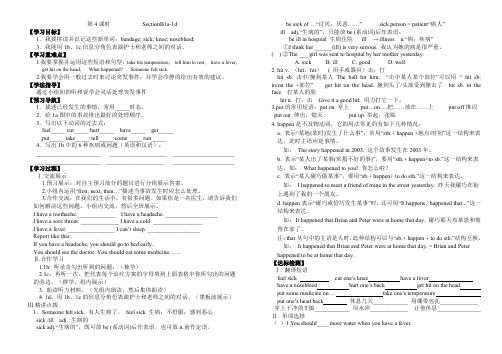
第4课时SectionB1a-1d【学习目标】1.我要拼读并识记这些新单词:bandage; sick; knee; nosebleed;3.我能用1b、1c信息分角色表演护士和老师之间的对话。
【学习重难点】1.我要掌握并运用这些短语和句型:take his temperature, tell him to rest, have a fever,get hit on the head, What happened? Someone felt sick.2.我要学会用一般过去时来讨论突发事件,并学会冷静的给出有效的建议。
【学法指导】通过小组间的听和说学会灵活处理突发事件【预习导航】1.描述已经发生的事情,常用_____时态。
2.给1a图中的事故排出最好的处理顺序。
3.写出以下动词的过去式:feel_____ cut_____ hurt_____ have_____ get_____put_____ take_____ tell_____ come_____ run_____4.写出1b中的6种疾病或问题(英语和汉语):______________________ ____________________ _____________________ ______________________ ____________________ _____________________ 【学习过程】Ⅰ.交流展示1.预习展示:对自主预习部分的题目进行分组展示答案。
2.小组内运用“first, next, then…”描述当事故发生时应怎么处理。
3.合作交流:在我们的生活中,有很多问题。
如果你是一名医生,请告诉我们如何解决这些问题。
小组内交流,然后全班展示。
I have a toothache._____________ I have a headache. __________________I have a sore throat. _____________ I have a cold. _________________I have a fever. ________________ I can’t sleep. __________________Report like this:If you have a headache, you should go to bed early.You should see the doctor. You should eat some medicine. …..Ⅱ.合作学习1.1b: 听录音勾出听到的问题。
M5U1Project1公开课

Listen to the article on Page 18 . Firstly , please number the paragraphs from 1—5.While
Listening try to get the main idea of each part.
One word each blank
regardless of
不管,不顾
I'll take the job regardless of the pay.
The law requires equal treatment for all, regardless of race, religion or sex. He continued speaking, regardless of my feelings on the matter.
4. The qualities that boys and girls consider important in a friend seem to be the same, regardless of the basis of these friendships.L22 定语从句 that 引导____________ 无论男孩和女孩友谊的基础是什么,他们所看 重的朋友身上的品质似乎是一样的。
regardless of
不管,不顾
I'll take the job regardless of the pay.
The law requires equal treatment for all, regardless of race, religion or sex. He continued speaking, regardless of my feelings on the matter. Regardless of danger, he climbed the tower.
How to make a great Oral Presentation

H O W T O P R E P A R E A NCCORDING TO SPEAKING CONSULTANT Lilyan Wilder (1999), two of the greatest mythsabout delivering oral presentations are that you’re better off “winging it” and that good speakers are “naturals.”In order to give an effective presentation, it is necessary to prepare and practice, practice,practice. Despite the need to prepare, one of your goals still should be to sound spontaneous and comfortable while delivering your message in a clear, organized, and stimulating fashion. The information below should help you achieve this goal:FIRST STEPSHERE ARE A FEW steps you need to take before writing your presentation, including thinkingabout who your audience is, what the expectations for the speech are, and selecting an appropriate topic.Researching the topicIf you are presenting something that you’ve already written, then this step won’t require much work. Otherwise, you’ll need to follow the same procedures as with writing and narrowing down your topic for a research paper.Organizing and writing the speechThis requires a different approach than writing a research paper.Practicing the speech and handling logisticsThere are a number of details to prepare for in advance of delivering your presentation.Phrasing the speechA presentation requires different language and phrasing than a written document. A presentation is a dialogue. It should sound natural and be somewhat conversational.A TManaging your stage frightIf you are shy, or unaccustomed to talking to a group of people, there are things you can do to make yourself less anxious.Visual aidsThe big eventIt’s important to present yourself and your material in a polished, yet comfortable, fashion. If you’ve followed the ideas listed above, it should be a successful experience.Web sites of InterestWe have identified a number of Web sites offering information about preparing oral presentations and related issues.ReferencesPRELIMINARY STEPS FOR PREPARING AN ORAL PRESENTATIONAnalyzing the situationBEFORE YOU DECIDE on a topic for your speech, it’s important to think about how to make your presentation interesting to your teacher and classmates. This may sound obvious, but have you looked at the material that you’ve covered so far in class? How could you relate what you want to say to what’s already been taught? Relating your material to information your audience is already familiar with will not only demonstrate to the teacher that you’ve been paying attention, it will also help your classmates understand and remember your points.Example: If you’ve examined a particular novelist in your literature class, you may want to refer to that novelist again in your talk on literary styles.Know how much time you have, how loudly you will need to speak for your classmates to hear you, and how many people will be in the audience. These facts will help determine the depth of your talk, the visual aids you can use, and the environment for your presentation.Choosing a topic and a focusChoose a topic that not only excites you, but one about which you either are an expert or can become one. You may not have a choice about your topic, but regardless of the subject, you still make decisions about what direction you’re going to take. Try to relate your topic to current issues, whether they are happening at your school, in your city, or in the world. Timeliness can make a presentation more interesting to your audience.In order to focus on a topic, follow these steps:Determine your general goal,e.g., to talk about recycling in the city.Develop a precise objective, e.g., to instruct people about the recycling facilities andprograms in the city of Chicago.Develop a precise objective,e.g., to instruct people about the recycling facilities andprograms in the city of Chicago.Develop a one-sentence summary,e.g., There are many recycling facilities in the city of Chicago that are not fully used.Develop a title,e.g., The Underuse of Chicago’s Recycling Facilities.Although there may be some overlap, try to decide what your main goal will be. This will help give your paper direction and consistency. Some important main goals include: InterestInformPersuadeMotivateResearching the TopicCollect more information than you think you need. As you prepare your presentation, you will whittle away at your notes and tighten your focus. Organize your information the same way that you would for a research paper.Recommendation:Read through your finished notes and label each section with a number or word that tells you where each thought fits into your outline (discussed in the next section of this Guide). Then, when you start to flesh out your presentation, you can quickly skim and organize your notes. ORGANIZING AND WRITING THE SPEECHDEVELOPING AN ORAL presentation is different than writing a report that will be read silently.The audience can’t turn back to the first part of your speech and examine what you said. That’s why speakers often repeat themselves throughout their presentations. The informal formula for public speaking is “First, tell the audience what you are going to tell them; then tell them; then tell them what you just told them.”You should follow this same mantra when structuring the notes that will serve as the basis for your oral presentation. Not only should you repeat some things, but you should also be extremely organized, so your listeners can easily follow what you say.The first step to take before writing your speech is to create an outline. Write down three to four main points, fill them in with subheadings, and then add third-level subheadings. Make each point a complete sentence. This skeletal structure will be the outline for your other notes, andeventually, the speech itself. Most word processing software includes an outlining feature, which may help.Suggested organization:IntroductionIn addition to your main points, you need an introduction and a conclusion. The introduction should capture the audience’s attention and warm you up. Some experts recommend humor, but exercise caution; if your joke falls flat, you immediately lose your audience. It’s better to start on a genuine note. Some suggestions (Dodd, 1997) for introductions include:Refer to a local event or a recent event in the newsTell a personal story, preferably one that is humorousRead a quoteAsk a questionRefer to something that’s just happened in classNo matter which of these devices you use, they should be tied somehow to your topic. Make a statement that somehow connects the introduction to the body of the talk.Main pointsInclude at least three or four main points.ConclusionEither end with a concluding statement or invite questions, or both. When you end your speech, only use the words “in conclusion,” “finally,” or “one more thing” if you are really finished. Also, don’t end your speech suddenly without recapping what you’ve said (remember to remind your audience of what you’ve just told them).PRACTICING THE SPEECH AND HANDLING LOGISTICSYOU SHOULD PRACTICE your speech at least once before you present it. Practice in anenvironment that is as similar as possible to where you’ll be giving the presentation. Practice in front of people and use your visual aids. Your talk should be a combination of entertainment, information, and intellectual stimulation, all delivered with a spontaneous and comfortable feel. The following guidelines will help you achieve this:Do not memorize a paper and deliver it verbatim. You may want to memorize certain small sections, and you will want to know the order of your presentation by heart, but the goal is to sound natural. Reading lines does not sound spontaneous unless you’re a really good actor.Write in large, boldface letters, regardless of whether you use note cards or regular paper for your notes. In order to engage your audience, you should look up from your paper or notes several times during the presentation, and you don’t want to lose your place when you look back down at the text. Using note cards makes it easier to find your place, but some people don’t like flipping through cards.Try recording yourself and listening to the tone, pitch, and speed of your voice. Work on sounding natural and relaxed.Pause naturally as you would in conversation.Practicing your speech out loud can help you clarify your thoughts. As you practice, don’t be afraid to add ideas or change what you’ve planned.You may want to add directions on your notes like “slow down,” “look at the audience,”and “remember to pause.” These will remind you to do the things that are sometimes hard to remember during the excitement of speaking in front of a group.LogisticsIf you’re going to use any kind of equipment, make sure that everything is in working order before you arrive for your presentation. Try to anticipate what problems might arise, and how to solve them. For example, “what will you I do if the computer crashes?” Or, “what will I do if the person who speaks before me takes up too much time, and I have to shorten my speech?” Be prepared for all the possible things that can go wrong.If you’re not giving your presentation in a familiar location (like your classroom), check out the space before the day of your presentation so you know how big the room is and what kind of technical options are available (and functioning). Will you need a microphone? Is there an Internet hook-up? Do the electrical outlets and lights work? How are they controlled? If you will need a projection screen, is there one already in the room? If so, how does it work? These are all important details.PHRASING THE SPEECHYOU SHOULD USE different language for an oral presentation than you would for a research paper. A speech should not sound as formal as a report. Remember that you’re talking, and that people will respond better when the language is familiar. Here are a few ways in which oral communication differs from written (Dodd, 1997):More audience-specificMore interactiveMore immediateMore personalMore informalMore opportunities to use visual communicationNot only is the style of a presentation different from that of a paper, but the language is as well. Here are a few considerations for phrasing your oral presentation:Use conjunctions—they sound more natural.Use vocabulary that will be understood. Your audience won’t have time to look up unfamiliar words.Use enumeration to tie your points together. (i.e., First I would like to discuss this issue. Second …)Use parallel construction in your phrasing to help the audience follow what you’re saying.Use personal pronouns and refer to yourself and the audience.Interject ideas and comments—make it personal!Ask occasional questions.With all of this advice about what you should say, it’s easy to forget one of the most important tips of all—do not be afraid of silence! Pause occasionally.MANAGING STAGE FRIGHTRECENT STUDY suggests that people unfamiliar with communication theory think that stagefright is caused mostly by what happens during the speech (Bippus & Daly, 1999). Inactuality, what happens before the speech affects your state of mind as much—if not more—than the speech itself. In other words, practicing and preparing are two of the best ways to eliminate stage fright.Overcoming Stage FrightPractice in a place or situation as similar as possible to where you will be giving your talk. This includes practicing in front of people, preferably classmates.Watch or listen to other speeches, either in person or through (audio or video)recordings. Take note of what works and what doesn’t.Use mental imagery to picture yourself in front of an audience. Try to becomecomfortable with the idea.Before you practice, and again before you deliver your presentation, perform voice and breathing exercises to warm up your vocal cords.If your hands shake, hold on to something like a small object, a pointer, or a lectern.Have water with you if possible, both during practice and while presenting.Take pauses and breathe normally.Try to establish a dialogue with the audience. This will make the whole experience feel more natural.VISUAL AIDS HEN YOU CREATE and display visual aids during an oral presentation, there are a fewgeneral principles that you should follow.Keep it simpleA WUse color, but not too muchColor accelerates learning and recall by 55% or more and comprehension by 70% (Dodd, 1997). But too much color can be distracting.Break complex ideas into simpler visual partsIf you plan to show a complex idea visually, break the image into smaller, less complicated parts. An overlay is a possible option.Show = DiscussDo not show anything that you don’t plan to discuss. Explain what’s in each graphic.Do not talk at your visual aidDirect your presentation toward the audience and refer to your images with a pointer or pen.Steady handsIf you’re hands are shaky, a pointer, pen, or pencil will help steady you.You can use the following options, but beware of the problems associated with each: Overheads are simple and clear, and you don’t have to depend on a computer. They can, however, get out of order, have poor print quality, and cause other problems if the transition between each one is not smooth. If you are able, have someone else be responsible for turning your overheads during your presentation, so you can concentrate on speaking and directing the overall presentation.PowerPoint or similar slide-show software programs can produce professional-looking presentations. You can store your presentation on a disk and carry it with you, and it’s also easy to make changes to your presentation. However, using such software does force dependence on computer technology, and if the computer crashes, or if there are other technology problems, you won’t have your slide-show. Therefore, when you use such software, always have available alternative visuals such as overheads or paper handouts.Slides give you clear images of photographs and also allow for easy change in the order of your presentation. However, they can be expensive, and you can’t change the images once they’re created.Whiteboards and paper are convenient if you feel comfortable writing your points in front of the audience. They also let you be spontaneous and incorporate feedback from the audience. However, they don’t look as professional as other media, and they force you to spend a lot of time writing when you should be talking (often with your back to the audience).Handouts are an excellent accompaniment to any of the options listed above, but they can also pose their own problems. If you distribute them at the beginning of your presentation, you risk losing your audience’s attention; their attention may turn to the handout rather than following what you are saying.Nevertheless, having the audience follow along with the handout can be a successful strategy. You can also pass out a summary of your speech that the audience can take away with them. A final option is to pass out handouts to support the information you bring up as you talk. However, this can also deflect attention away from you, and cause the audience to miss pertinent points. Be sparing with handouts, but understand that they can be instrumental in helping the audience remember your speech.THE BIG EVENTIN ADDITION TO some common sense tips—like getting a good night’s sleep the night before and eating breakfast—here are some other helpful ideas.Warm up with breathing and vocal exercises.Take a deep breath before walking to the front of the room.Walk slowly to the front, pause, and look at the audience before speaking.Learn to be comfortable with the sound of your voice.Remember to pause.Focus on the audience, not your notes or visual aids.Try to change the tone of your speech periodically to keep the audience’s attention.When it’s all over, ask for feedback, and remember that this is a learning experience. You’ll continue to become a better public speaker the more times you go through this process.WEB SITES OF INTERESTEffective Presentations Online Tutorial, University of Kansas/SAH/OTEd/jradel/effective.htmlDos and Don’ts of Oral Presentation, Voice For Success/doc3_pub.htmlMaking an Oral Presentation, University of Toronto/~writing/oral.htmREFERENCESBippus. A., & Daly, J. (1999)What do People Think Causes Stage Fright? Naïve Attributions about the Reasons for Public Speaking AnxietyCommunication Education, 48, 61-72.Dodd, J. (Ed.). (1997)The ACS Style Guide: A Manual for Authors and Editors (2nd ed.)Washington, DC: American Chemical Society.Menzel, K. & Carrell, L. (1994)The Relationship Between Preparation and Performance in Public SpeakingCommunication Education, 43,17-26.Mills, G. (1952)Composing the Speech.New York: Prentice-Hall.Ochs, D., & Winkler, A. (1983)A Brief Introduction to Speech (2nd ed.)New York: Harcourt Brace Jovanovich.Sullivan, L. (1994)Preparing Great Speeches: A 10-step Approach College & Research Libraries News, 55 (11), 710—714. Wilder, L. (1999)7 Steps to Fearless SpeakingNew York: John Wiley & Sons.。
高一英语M1U1Project导学案
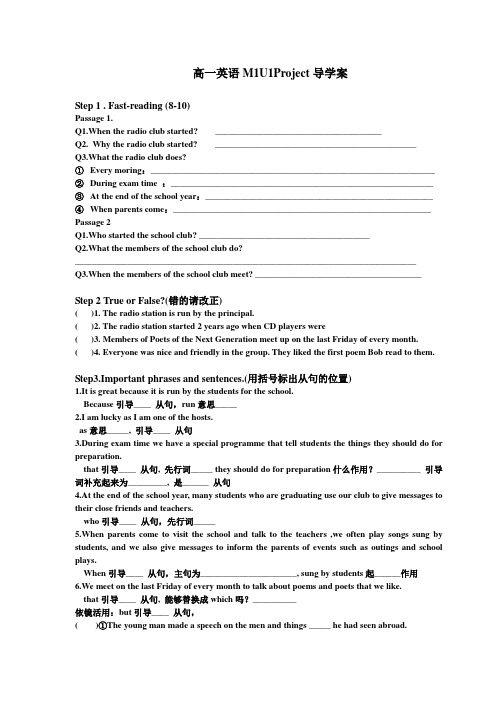
高一英语M1U1Project导学案Step 1 . Fast-reading (8-10)Passage 1.Q1.When the radio club started? ______________________________________Q2. Why the radio club started? ______________________________________________Q3.What the radio club does?①Every moring:_________________________________________________________________②During exam time :____________________________________________________________③At the end of the school year:____________________________________________________④When parents come:___________________________________________________________ Passage 2Q1.Who started the school club? _______________________________________Q2.What the members of the school club do?______________________________________________________________________________Q3.When the members of the school club meet? ______________________________________Step 2 True or False?(错的请改正)( )1. The radio station is run by the principal.( )2. The radio station started 2 years ago when CD players were( )3. Members of Poets of the Next Generation meet up on the last Friday of every month. ( )4. Everyone was nice and friendly in the group. They liked the first poem Bob read to them.Step3.Important phrases and sentences.(用括号标出从句的位置)1.It is great because it is run by the students for the school.Because引导____ 从句,run意思_____2.I am lucky as I am one of the hosts.as意思_____, 引导____ 从句3.During exam time we have a special programme that tell students the things they should do for preparation.that引导____ 从句, 先行词_____ they should do for preparation什么作用?__________ 引导词补充起来为_________, 是______ 从句4.At the end of the school year, many students who are graduating use our club to give messages to their close friends and teachers.who引导____ 从句,先行词_____5.When parents come to visit the school and talk to the teachers ,we often play songs sung by students, and we also give messages to inform the parents of events such as outings and school plays.When引导____ 从句,主句为______________________, sung by students起______作用6.We meet on the last Friday of every month to talk about poems and poets that we like.that引导____ 从句, 能够替换成which吗?__________依镜活用:but引导____ 从句,( )①The young man made a speech on the men and things _____ he had seen abroad.A.whomB.whoC.whichD.that7.I was a little nervous at first, but everyone was so nice and friendly that I soon stopped worrying. but引导____ 从句,so…that意思_____,引导____ 从句写出中文意思1.be run by(line2) ________2.be allowed to(line5) _______3.during break time(line7)____4.approve the idea(line8)________5.much more than(line10)______6.do sth. for preparation(line13)__________7.give messages to their close friends(line15)________8.play songs sung by students(line18)________rm the parents of events(line18)__________ 10.read them out loud (line4)___________ 11. be required to write a poem(line6)_______________ 12.a little scary(line7)___________13.have it approved by your teacher(line2)__________________ 14.be responsible for ____________ 15.achieve one’s goals____________ e up with________ 17.consist of ==be made up of _______ 18.it’s time to do _________ 19.be based on _____20.on the school display wall ________ 21.sign up____________nguage points1.run vt. 经营,管理;驾驶run a company/a school/a club/a carvi.运行,运转/流动The water run day and nigh.短语链接: run out of 用完,耗尽(人做主语)run out 被用完(物作主语)run over 碾压,跑过去,溢出run after 追捕,追求,跟踪run into 偶遇,撞上run away 逃走run for 竞选依镜活用:( )①The factory ____ by the young man has been developing very fast since it was set up.A.manageB.runC.operatingD.to charge( )②I hope ____ my own business.A.to runB.runningC.to workD.working( )③Don’t leave the water ______ while you brush your teeth.A.runB.runningC.being runD.to run选词填空(run into/after/away/out (of))④Look!The dog is __________ a rabbit.⑤He is lucky enough to _________ from a fire.⑥We are _______ the fuel.2. approve vt. 批准,许可approve sth. vi. 同意,赞同approve of (doing) sth.延伸:名词为____ 反义词_______I approve of your trying to earn some money,but please don’t neglect your lessons.翻译:_____________________________________________________________依镜活用:①we had to wait days for the school ______________our plan to plant more trees around our school this spring.②Mrs Brown doesn’t _______________________in public.(赞成吸烟)3. as①.I am lucky as I am one of the hosts. as意思_____②As you weren’t there, I left a message.as意思_____③I am in charge of the radio club as the oldest student member. as意思_____4. charge vt.向…… 要价,索价,喊价charge sb.some moneyn.in charge of sth.负责,掌管sth be in the charge of sb由。
24个英语话题高中英语课本巩固篇
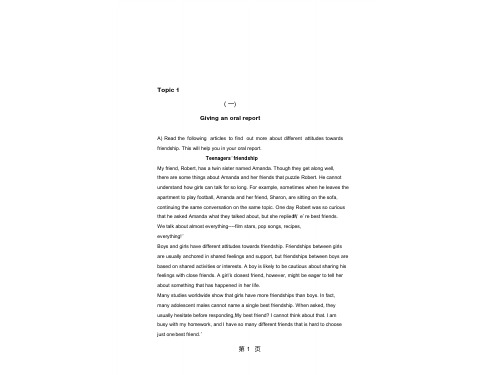
When deciding what is most important in life, some people choose money, while others choose things like security and comfort. However, for me, the most important thing in life is friendship. I cannot imagine being without it. Friendship means not being alone. Once I was traveling by myself through Beijing on the way to my grandparents’house. Since my next train left in the evening, I had a day for sightseeing. I did not mind being alone, but then I saw all of the tourists having their pictures taken together, and I began feeling sad. I ended up returning to the station and spending the rest of the day in the waiting room. Life is no fun without a companion to share it with. Friendship means having someone I can rely on. Last year, I forgot my schoolbag on a trolleybus, and I lost all of my notes for the final exam. You can imagine how I panicked. Luckily for me, my best friend Jenny let me copy her notes, and I used them in my revision. Thanks to her help, I was able to pass the exam.
高中英语 unit 1 Getting along with others Project Giving an oral report学案 牛津版必修5
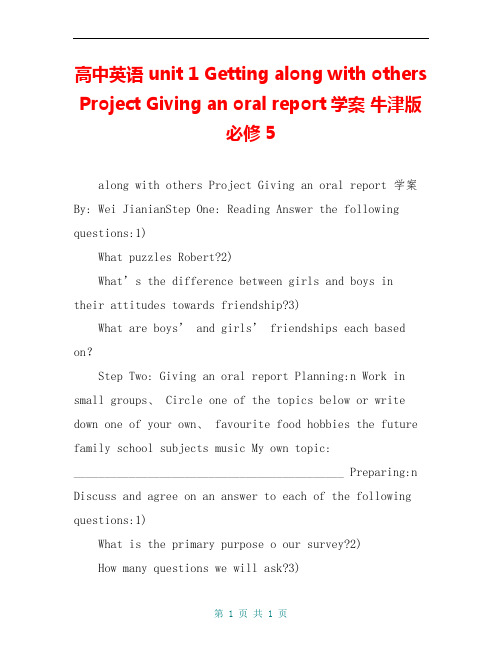
高中英语 unit 1 Getting along with others Project Giving an oral report学案牛津版必修5along with others Project Giving an oral report 学案By: Wei JianianStep One: Reading Answer the following questions:1)What puzzles Robert?2)What’s the difference between girls an d boys intheir attitudes towards friendship?3)What are boys’ and girls’ friendships each based on?Step Two: Giving an oral report Planning:n Work in small groups、 Circle one of the topics below or write down one of your own、 favourite food hobbies the future family school subjects music My own topic:____________________________________________ Preparing:n Discuss and agree on an answer to each of the following questions:1)What is the primary purpose o our survey?2)How many questions we will ask?3)Who will take our survey? Producing:n The entiregroup should agree on and approve the questions、Presenting:n After the report is written, it is time to present your findings to the clad in an oral report、n Discuss the conclusions the group has come to regarding differences between the attitudes of teenage boys girls、n Answer any questions your classmates have about your survey or results、n Post a copy of your survey andresults on the display wall of your classroom、Step Three: Language Points1)attitude n、姿势,姿态;心态,看法People’s attitude __________ the accident varies widely、What’s yourattitude ________ the result of the foot match?take an attitude of … 采取……态度take a/an … attitude towards sb/sth 对某人或某事采取/抱有……态度2)regardless adj、不管……的;不顾……的(同of连用,作状语)He says what he thinks, ___________ of other people’s feelings、The goal is to make higher education available to everyone who is willing and capable ________ _____ his financial situation、 adv、无论如何;不管;不顾Step Four: Homework: To do Parts B1 and B2 on page91 in Workbook To do parts D1 and D2 on page93 in workbook。
高二英语Module 8 Unit one Project导学案
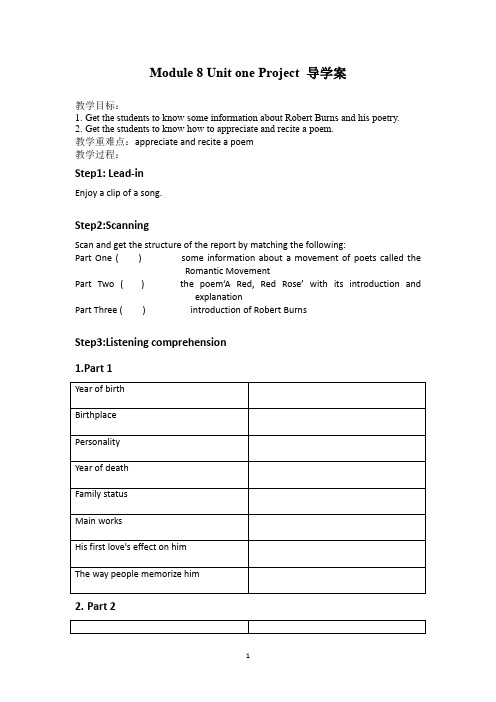
Module 8 Unit one Project 导学案教学目标:1.Get the students to know some information about Robert Burns and his poetry.2.Get the students to know how to appreciate and recite a poem.教学重难点:appreciate and recite a poem教学过程:Step1: Lead-inEnjoy a clip of a song.Step2:ScanningScan and get the structure of the report by matching the following:Part One ( ) some information about a movement of poets called theRomantic MovementPart Two ( ) the poem‘A Red, Red Rose’ with its introduction andexplanationPart Three ( ) introduction of Robert BurnsStep3:Listening comprehension1.Part 12.Part 23.Part 3(1)What did the poet compared the idea of love to?The poet compared the idea of love to _________ and _______.(2)What does “sands o’ life” mean?a. Time flies quickly, so we should treasure time.b. Love is great, but it has its limits.c. Life consists of happiness and sadness.d. Life is worthless like sands.(3) Who does the poet want to say goodbye to?_____________________________________________________________________Step4: Appreciating a poem1.Why does the spelling of the words look rather strange?_____________________________________________________________________ 2.What is the structure of this poem?The poet divided this poem into ___________________________________________ 3.Can you find the rhymes and analyze the rhetoric(修辞) in this poem?_____________________________________________________________________ _____________________________________________________________________Step5: Listening and reciting the poemA RED, RED ROSEBY ROBERT BURNSO my Luve’s like a red, red roseThat’s newly sprung in June:O my Luve’s like the melodieThat’s sweetly play’d in tune!As fair art thou, my bonnie lass,So deep in luve am I:And I will luve thee still, my dear,Till a’the seas gang dry:Till a’the seas gang dry, my dear,And the rocks melt wi’the sun;I will luve thee still, my dear,While the sands o’life shall run.And fare thee weel, my only Luve,And fare thee weel a while!And I will come again, my Luve,Tho’it were ten thousand mile.Step6: Useful phrases1.苏格兰的文学巨匠____________________2.因…而出名_________________3.鼓励他创作诗歌______________________4.出版________________________5.虚弱的体质__________________________6.哀悼某人的死亡_____________7.捐钱来赡养某人_______________________8.一尊彭斯的塑像______________9.这座纪念彭斯的纪念碑_________________ 10.属于______________________ 11.关注________________________________ 12.往往做某事________________ 13.谈及,涉及_________________________ 14.目的是;旨在______________ 15.由......组成/构成______________________ 16.并无不同__________________ 17.把…比喻成…______________________ 18.只要______________________ Step7: Assignments(请在/ 下载)。
M5U1 Project Giving an oral report(公开课课件)
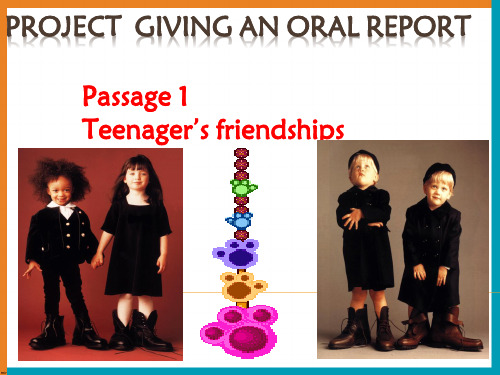
Write a report. Present your report to the whole class.
The different 2_________ attitudes towards friendship between girls and boys
▼Although boys and girls tend to share different Conclusion things in their friendships, both of them 8.___________ qualities in a friend are important . think9___________ friends in our lives . ▼Every one of us need 10 _______
Careful Reading
Fill in each blank with no more than three words.
Lead--in
twin brother Robert ,1. the _______________of Amanda, can’t understand girls’ friendship--- the girls talk about the same topic for so long. ▼Friendships between girls are based on shared 3____________. feelings and support ▼Friendships between boys are based on shared activities or interests Boys will be cautious about 4______________. sharing their feelings with friends. 5_______ ▼Many studies show that girls have more friendship and it’s easy for girls to tell their best friends’6_____ names ▼Many boys fail in telling a best friend’s name and some excuses avoid the question. may find 7____________to
模块5 Unit 1 Project Giving an oral report教案(译林牛津版高二

模块5 Unit 1 Project Giving an oral report教案(译林牛津版高二英语必修五教案教学设计)Teaching Aims:To learn the passage Teenagers’ friendshipsTo help students to learn and use English practicallyTo help students to understand about the differences between teenage boys’ and girls’ friendshipsTo apply what they have learnt to prepare an oral report to present to the classTeaching Key Points:The usages of the words like attitude, regardless etc.Teaching Difficulties:How to complete the oral reportTeaching Procedure:Step One: ReadingT: (Greet the class as usual) In this unit, we mainly talked about friendship. It plays an important role in our lives. Everybody needs friends. However, girls and boys have differenttypes of friendships and different attitudes towards friendship. Next please read the passage about different attitudes teenage boys and girls have about friendships and answer the following questions:1) What puzzles Robert?2) What’s the difference between girls and boys in their attitudes towards friendship?3) What are boys’ and girls’ friendships eac h based on?Suggested Answers:1. Some things about Amanda and her friends. (He can’t understand what girls can talk about for so long.)2. Girls always have a lot to talk about with their best friends and have more friendships than boys. Boys cannot name a single best friend.3. Girls’ friendships are based on shared feelings and support while boys’ are based on shared activities or interests.T: Very good! Then do you agree with these differences between teenage boys’ and girls’ friendships?Ss: …Step Two: Giving an oral reportT: Ok, next we will plan and conduct a survey and prepare an oral report to present to your class. Let’s complete it step by step.Planning:Work in small groups. You will discuss and decide on a certain topics on the different attitudes between boys and girls. Circle one of the topics below or write down one of your own.favourite food hobbies the futurefamily school subjects musicMy own topic:____________________________________________(Make sure that all the group members agree on the topic they choose and that different groups choose different topics.Preparing:Now that you have chosen your topic, your group will need to discuss and agree on an answer to each of the following questions:1) What is the primary purpose o our survey?2) How many questions we will ask?3) Who will take our survey?Discuss the tasks listed below and decide which group member will responsible for the task. Write the names beside the work each member is going to do .1) Write survey questions/Design the survey____________________2) Conduct the survey and calculate the results__________________3) Write the report_________________________________________4) Present the oral report____________________________________( Ask students to discuss the three major questions first. Then they should decide what each group member will be responsible for to finish each task. Set a deadline for it.)Producing:Members responsible for writing the survey questions need to write multiple-choice questions that can be answered quickly and are easy to total when the survey is complete. The entire group should agree on and approve the questions.A sample QuestionnaireTick the answer which most applies to you.1. Are you a boy or a girlBoy □ Girl □2. How many best friends do you have?A lot □ A few □ None □3. How often do you have a long conversation with your friends?More than three times a week □ Once a week □Seldom □ Never □4. What topics do you usually talk about with your best friends?Hobbies and interests □ Families and friends □School and study □ Emotions and feelings □Future plans and dreams □5. Do you share your secrets with your best friend?Always □ Sometimes □ Never □6. Do you think boys and girls have the same attitudes towards friendship?Yes □ No □7. If you choose No to Question 6, what different attitudes do you have?Girls seem to have a lot to talk about with their best friends. □Girls’ friendships are based on shared feelings and support. □Boys’ are based on shared activities or interests. □Girls have more friendships than boys. □(T shows the above as a example to help students to complete the project and students can remove some of them or add their own questions.)Conduct the survey and calculate the results. Add up the total number for each response and then calculate the differences between answers given by boys and girls.Students writing the report need to briefly discuss the conclusions the group has drawn, based on the survey results. This should include the different answers given by boys and girls as well as similar answers.Presenting:After the report is written, it is time to present your findings to the clad in an oral report.Discuss the conclusions the group has come to regarding differences between the attitudes of teenage boys girls.Answer any questions your classmates have about your survey or results.Post a copy of your survey and results on the display wall of your classroom.Step Three: Language Points1) attitude n. 姿态,姿势;心态,看法e.g. People’s attitude towards the accident varies widely.e.g. What’s your attitude towards the result of the foot match?take an attitude of … 实行……态度take a/an … attitude towards sb/sth 对某人或某事实行/抱有……态度2) regardless adj. 不管……的;不顾……的(同of连用,作状语)e.g. He says what he thinks, regardless of other people’s feelings.e.g. The goal is to make higher education available to everyone who is willing and capable regardless of his financial situation.adv. 无论如何;不管;不顾Step Four: Homework:To do Parts B1 and B2 on page 91 in WorkbookTo do parts D1 and D2 on page 93 in workbook文档内容到此结束,欢迎大家下载、修改、丰富并分享给更多有需要的人。
口头报告英文作文
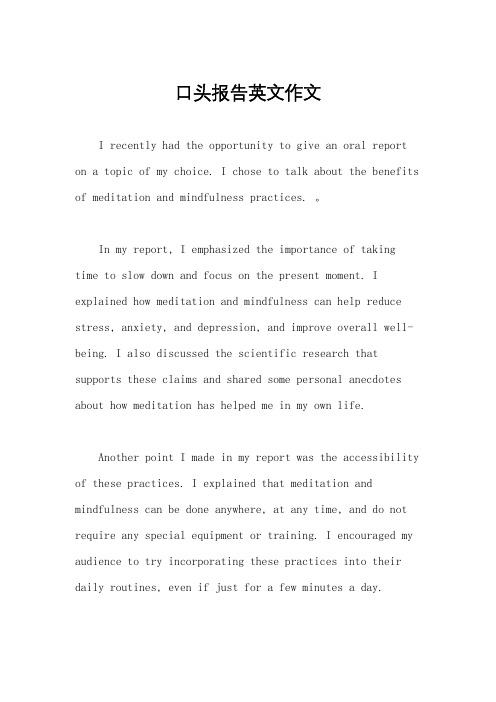
口头报告英文作文I recently had the opportunity to give an oral report on a topic of my choice. I chose to talk about the benefits of meditation and mindfulness practices. 。
In my report, I emphasized the importance of taking time to slow down and focus on the present moment. I explained how meditation and mindfulness can help reduce stress, anxiety, and depression, and improve overall well-being. I also discussed the scientific research that supports these claims and shared some personal anecdotes about how meditation has helped me in my own life.Another point I made in my report was the accessibility of these practices. I explained that meditation and mindfulness can be done anywhere, at any time, and do not require any special equipment or training. I encouraged my audience to try incorporating these practices into their daily routines, even if just for a few minutes a day.As I wrapped up my report, I emphasized the importanceof approaching meditation and mindfulness with an open mind and a non-judgmental attitude. I encouraged my audience to be patient with themselves and to not get discouraged if they do not see immediate results. I also providedresources for further exploration and learning on the topic.Overall, I found giving an oral report to be a great opportunity to share my knowledge and enthusiasm for atopic that is important to me. I enjoyed the challenge of trying to make my language sound natural and conversational, and I hope that my report inspired others to explore the benefits of meditation and mindfulness.。
Unit 1 第2课时 (Section A 3a-3c )(导学案)
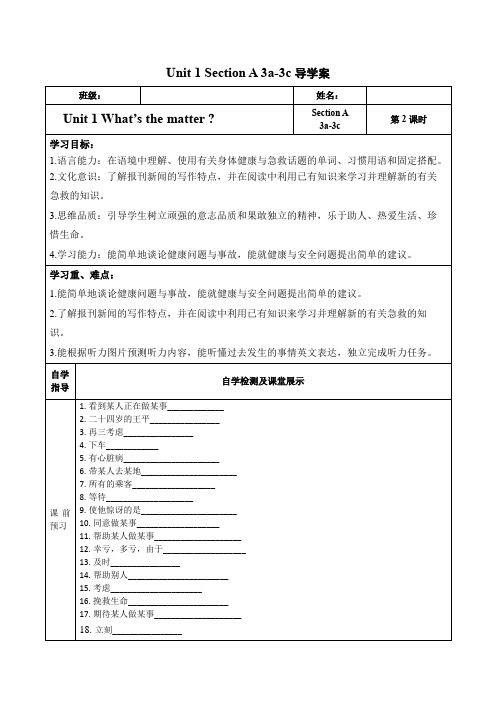
Unit 1 Section A 3a-3c导学案1.Read the passage quickly and match the main ideas with each paragraph.What was the result of the story? Para.1How people saved the old man? Para.2What the bus driver saw? Para.32.Read Para.1 and find the information.When At 9:00 a.m. yesterdayWhere ___________________Who ___________________What ___________________3.Read Para.2 and fill in the blanks.How did they save the old man?4.Why was Wang Ping surprised that the passengers agreed to go to the hospital with him? ________________________________________________________________________5.What do you think of the news language?________________________________________________________________________ 6.What was the result of the story?(Para.3)Para 3: 1.The man __________by the doctors____________.2. One passengers says, “It’s__ that many people don’t want ____ ____.” (Ending)3.The driver didn’t __________himself. He only thought about ________.After reading the passage please check(√) the things that happened in the story.1.__ Wang Ping was the driver of bus No. 26 at 9:00 a.m. yesterday.2.__ Bus No. 26 hit an old man on Zhonghua Road.3.__ The old man had a heart problem and needed to go to the hospital right away.4. __ The passengers on the bus did not want to go to the hospital, so only Wang Ping wentwith the woman and the old man.5. __ Some passengers helped to get the old man onto the bus.6. __ The old man got to the hospital in time.Let’s retellLet’s thinkWhat do you think of the driver?Let’s discussDo you agree that people do not help others because they do not want to get into trouble ? Why or why not ?What should we do?一、单项选择【参考答案】1.Let’s predict !2.It comes rom a newspaper. (the eye of news, New in time, True in story)3.1.What was the result of the story? (Para.3)How people saved the old man? (Para.2)What the bus driver saw? (Para.1)2.3.4.Because he expected most or all of the passengers to get off and wait for the next bus. But to his surprise, they all agreed to go with him.5.Simple and lively6.7.Because many people don't want to help others because they don't want any trouble.8.Because they agreed to go with him.What do you think of the driver ?Kind ,helpful, calm, understanding, warm-hearted, selfless.What should we do ?ask quickly and then decide what to do next;call the police and their family in time;if possible, help them when there are other people;So,we should help others without thinking twice.But at the same time,we should protect ourselves.。
【范文】“Project Giving an oral report”教案
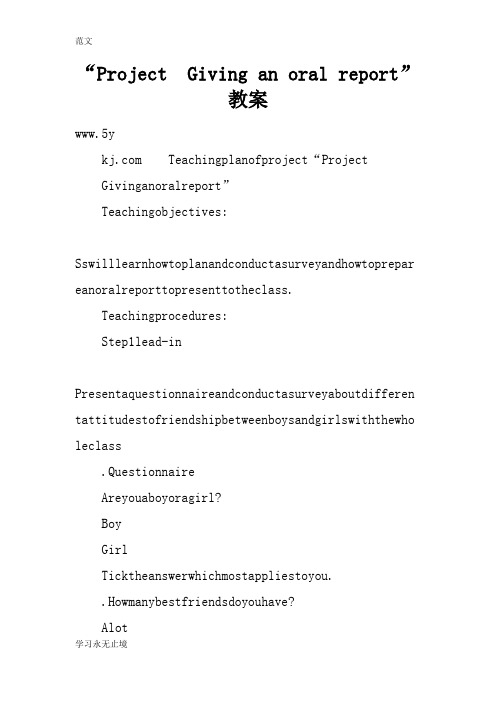
“Project Giving an oral report”教案www.5y Teachingplanofproject“ProjectGivinganoralreport”Teachingobjectives:Sswilllearnhowtoplanandconductasurveyandhowtoprepar eanoralreporttopresenttotheclass.Teachingprocedures:Step1lead-inPresentaquestionnaireandconductasurveyaboutdifferen tattitudestofriendshipbetweenboysandgirlswiththewho leclass.QuestionnaireAreyouaboyoragirl?BoyGirlTicktheanswerwhichmostappliestoyou..Howmanybestfriendsdoyouhave?AlotNone2.Howoftendoyouhavealongconversationwithyourfriends?morethanthreetimesaweekonceaweekseldomnever3.whattopicsdoyoumostlytalkaboutwithyourfriends?HobbiesandinterestsFamiliesandfriendsSchoolandstudyEmotionsandfeelingsFutureplansanddream4.Doyoushareyoursecretswithyourbestfriends?AlwaysSometimesNever5.Doyouthinkboysandgirlshavethesameattitudestowards friendship?No6.IfyouchooseNotoQuestion5,whatdifferentattitudesdo theyhave?Friendshipsbetweengirlsareusuallybasedonsharedemoti onsandsupport.However,friendshipsbetweenboysareusua llybasedonsharedactivitiesorinterests.Girlsseemtohavealottotalkaboutwiththeirbestfriendst hanboys.Girlshavemorefriendshipsthanboys.Step2readingISkimmingQuestions:.whatisthepassagemainlydiscussing?2.whatpuzzlesRobert?3.what’sthedifferencebetweenboysandgirlsintheirattitudesto wardsfriendship?4.whatareboys’andgirls’friendshipseachbasedon?IIScanningLanguagepoints.puzzlevt.困惑;苦思Thismysterypuzzlesme.这件神秘事情使我百思不解. Iampuzzledbythedifficultquestions.puzzleout经过苦思想出;猜出puzzleover苦思苦想puzzledadj.迷糊的,困惑的觉得困惑的apuzzledexpression Hewasquitepuzzledaboutwhattodonext.他完全不知道接下去该怎么办. Iwaspuzzledtoseeherbehavinglikethat.看到她那样的举止使我感到困惑.2.absorbVt.useupmuchoftheattention,interestortimeof吸引…….的注意力或兴趣,耗费…的时间,使全神关注absorbentadj.能吸收的,有吸收力的,吸水的absorptionn.吸收,专注Heiscompletelyabsorbedinhisbusiness.他完全专心于他的业务Hewasabsorbedinabook.他全神贯注于一本书.3.attituden.cwayoffeeling,thinkingorbehaving态度意见,看法whatisyourattitudetowardsthisquestion?wemustmaintainafirmattitude.我们必须保持坚定的态度.4.consistent与…….一致,符合whatyousaynowisnotconsistentwithwhatyousaidlastweek.你所说的与你上星期所说的话不相符.consistentadj.一致的,经常的,一贯的consistentlyadv.Heisbeenaconsistentfriendtome.他是我历久不渝的朋友.Theideainhisvariousspeechesarenotconsistent.他在各项演说中所得的观念不一致.4.hesitate).vitostopandconsiderbeforeanaction犹豫;踌躇Andrewhesitatedbeforehetookthelastcake.安德鲁拿最后一块点心之前犹豫了一下.Hehesitatesatnothing.他对什么事都豪不迟疑.2).vt.不愿;不欲feelthatperhapsoneshouldnotdo;notwishtodo;beunwillingtodoIalwayshesitatetoadvisemyfriendsonwhattoread.我总是不大愿意指点我的朋友们该看些什么书.3).vt.怕麻烦别人beunwillingIfyouhaveanyquestions,don’thesitatetoaskme.如果你有什么问题,尽管问我.hesitationn.踌躇,犹豫anactofhesitatingHeacceptedtheinvitationwithouthesitation.他毫不犹豫地接受了邀请.5.basevt.basesth.on\upon建立在……基础之上,以……为根据Ibasemyhopesonthenewswehadyesterday.我的希望是以我们昨天所得到的消息为根据.Theirrelationshipwasbaseduponmutualrespect.他们的友谊建立在相互尊重的基础之上.6.regardlessof:不管,不论payingnoattentionto不顾,不注意Thelawrequiresequaltreatmentforall,regardlessofrace ,religionorsex.法律要求人人平等,不管是什么种族、宗教或性别。
Oral+Reports+and+Presentations
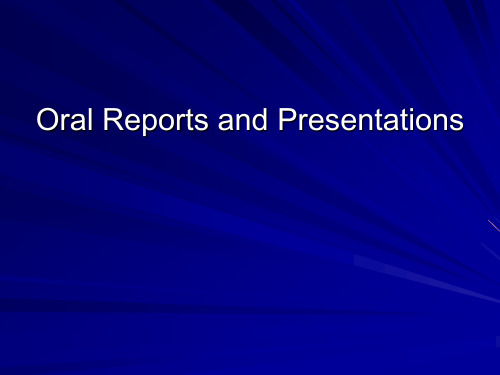
What I’ll Grade Specifically…
1. Content A. Байду номын сангаасorrect level for audience (Difficulty,
Interest) B. Introduction. Got attention, motivated
audience to listen. C. Distinguished between major and minor
Oral Reports and Presentations
Organization of Oral Reports
1. Identify the purpose of your presentation.
Like a written report, an oral report must: State the topic Make its purpose clearly evident Offer the audience a forecast, or layout of the report in the introduction
As a result, you won’t stumble over words and your pronunciation will also be much better.
Group Presentations
If you are giving a presentation with multiple speakers, do the following to prepare:
4. PowerPoint (and other visuals)
A. Easy to see. Clear. B. Avoided too much text. C. Graphics were helpful and understandable. D. Did you introduce the visuals, and could
“ProjectGivinganoralreport”教案
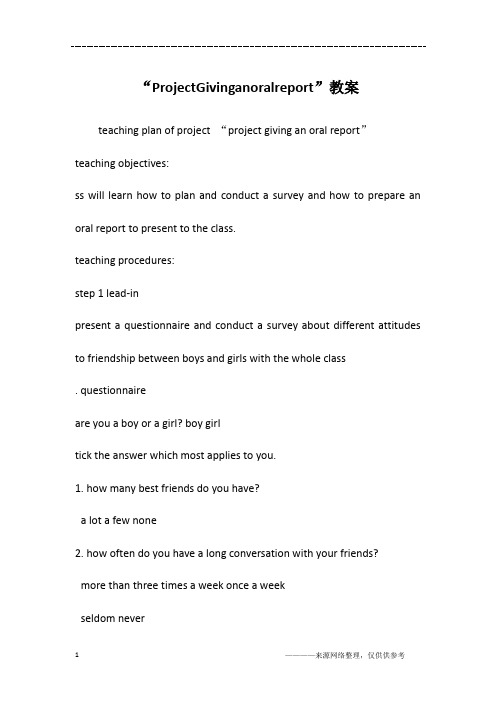
“ProjectGivinganoralreport”教案teaching plan of project “project giving an oral report”teaching objectives:ss will learn how to plan and conduct a survey and how to prepare an oral report to present to the class.teaching procedures:step 1 lead-inpresent a questionnaire and conduct a survey about different attitudes to friendship between boys and girls with the whole class. questionnaireare you a boy or a girl? boy girltick the answer which most applies to you.1. how many best friends do you have?a lot a few none2. how often do you have a long conversation with your friends?more than three times a week once a weekseldom never3. what topics do you mostly talk about with your friends?hobbies and interests families and friendsschool and study emotions and feelingsfuture plans and dream4.do you share your secrets with your best friends?always sometimes never5. do you think boys and girls have the same attitudes towards friendship? yes no6. if you choose no to question 5 , what different attitudes do they have? friendships between girls are usually based on shared emotions and support . however, friendships between boys are usually based on shared activities or interests.girls seem to have a lot to talk about with their best friends than boys. girls have more friendships than boys.step 2 readingi skimmingquestions:1.what is the passage mainly discussing?2. what puzzles robert?3. what’s the difference between boys and girls in their attitudes towards friendship?共3页,当前第1页1234. what are boys’and girls’friendships each based on?ii scanninglanguage points1. puzzle vt. 困惑;苦思this mystery puzzles me.这件神秘事情使我百思不解.i am puzzled by the difficult questions.puzzle out 经过苦思想出; 猜出puzzle over 苦思苦想puzzled adj. 迷糊的,困惑的觉得困惑的(about, as, to)a puzzled expressionhe was quite puzzled about what to do next.他完全不知道接下去该怎么办.i was puzzled to see her behaving like that.看到她那样的举止使我感到困惑.2. absorb vt. use up much of the attention, interest or time of 吸引…….的注意力或兴趣, 耗费…的时间,使全神关注absorbent adj. 能吸收的, 有吸收力的, 吸水的absorption n. 吸收, 专注he is completely absorbed in his business.他完全专心于他的业务he was absorbed in a book.他全神贯注于一本书.3. attitude n. c way of feeling, thinking or behaving 态度意见,看法what is your attitude towards this question?we must maintain a firm attitude.我们必须保持坚定的态度.4. consistent (with) 与…….一致, 符合what you say now is not consistent with what you said last week.你所说的与你上星期所说的话不相符.consistent adj. 一致的,经常的,一贯的consistently adv.he is been a consistent friend to me.他是我历久不渝的朋友.the idea in his various speeches are not consistent.他在各项演说中所得的观念不一致.4. hesitate1).vi to stop and consider before an action犹豫; 踌躇andrew hesitated before he took the last cake.安德鲁拿最后一块点心之前犹豫了一下.he hesitates at nothing.他对什么事都豪不迟疑.2). vt. 不愿; 不欲( hesitate to do)feel that perhaps one should not do ;not wish to do; be unwilling to doi always hesitate to advise my friends on what to read.我总是不大愿意指点我的朋友们该看些什么书.3). vt. 怕麻烦别人be unwilling ( to trouble somebody)if you have any questions , don’t hesitate to ask me.如果你有什么问题,尽管问我.hesitation n. 踌躇, 犹豫an act of hesitatinghe accepted the invitation without hesitation.他毫不犹豫地接受了邀请.5. base vt.base sth. on \ upon 建立在……基础之上, 以……为根据i base my hopes on the news we had yesterday.我的希望是以我们昨天所得到的消息为根据.their relationship was based upon mutual respect. 他们的友谊建立在相互尊重的基础之上. 共3页,当前第2页1236. regardless of : 不管, 不论paying no attention to 不顾,不注意the law requires equal treatment for all, regardless of race, religion or sex.法律要求人人平等,不管是什么种族、宗教或性别。
- 1、下载文档前请自行甄别文档内容的完整性,平台不提供额外的编辑、内容补充、找答案等附加服务。
- 2、"仅部分预览"的文档,不可在线预览部分如存在完整性等问题,可反馈申请退款(可完整预览的文档不适用该条件!)。
- 3、如文档侵犯您的权益,请联系客服反馈,我们会尽快为您处理(人工客服工作时间:9:00-18:30)。
A thousand friends are few, one enemy is too many.朋友千人尚觉少,仇敌一人犹嫌多。
1
Module 5 Unit 1 Getting along with others
Project1 Giving an oral report 导学案
姓名_______________ 班级____________________
【学习目标】
1. To develop reading ability by reading the article from the school magazine ;
2. To have a deep and clear understanding of different attitudes of boys and girls towards friendship;; 3 .To know the structure of a report and practice oral ability by anticipating in the oral report ;
4. To improve Ss‟ t eam work spirit by finishing and presenting the project ;
【情感目标】To improve Ss‟ emotional sense of friendship.
【重点】1. Reading comprehension of the passage.
2.Preparing to give an oral report.
【难点】Analysis of the structure of the report.
【自主学习】
1. Translate t he proverbs “人生在世无朋友,犹如生活无太阳” and “患难见真情”in to English.
2.Discuss the differences between boys‟ and girls‟ friendship according to the questionnaire.
Questionnaire
Are you a boy or a girl? Boy
1. How many best friends do you have? A lot A None
Hobbies and interests Families and friends
Always Sometimes Never
Yes 6. If you choose …No ‟ to Question 5, what different attitudes do they have?
【交流展示】1.让学生把谚语翻译在黑板上. 2.小组代表口头汇报问卷调查的结果。
【释疑点拨】
Ⅰ.Fast reading: Read the passage quickly, and find the answers to these questions:
1. What puzzles Robert?( No more than 10 words)
2. What are boys‟ and girls‟ friendships each based on? (No more than 19 words)
3. What do boys and girls consider important in a friend? (No more than 1 word)
Ⅱ.Careful reading: Read the passage carefully and then fill in each blank within three words.
【达标检测】Giving an oral report.
Give an oral report of the passage according to the key sentences of each part.
1. The topic: Boys and girls have ......
2.The different attitudes are clear.
1) Girls‟ friendship ….while boys‟ friendship…
2) Girls have….than boys.
3) Boys can't name .....while girls can name… without….
3. Conclusion: Boys share...;girls share....; Regardless of the differences,both of them are……
【Homework】Conduct a survey and present an oral report in three days.
Work in a group of six. Survey people to determine how attitudes between boys and girls differ on a certain topic.Choose one of the topics below then write down your report.
favorite food; hobbies ; dream ;
school subjects ; music ; books;
sports…
A thousand friends are few, one enemy is too many.朋友千人尚觉少,仇敌一人犹嫌多。
2。
